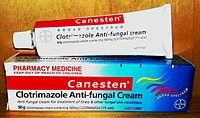
Photo from wikipedia
Modernity enjoys a broad and effective arsenal against superficial mycoses. However, the history of social stigma attached to dermatophyte infections, their unusual and often harmful treatments, and the controversial public… Click to show full abstract
Modernity enjoys a broad and effective arsenal against superficial mycoses. However, the history of social stigma attached to dermatophyte infections, their unusual and often harmful treatments, and the controversial public health efforts designed to limit their spread before the discovery of safe and efficacious antifungal agents is worthy of reflection. Tinea capitis and corporis were major public health challenges prior to the introduction of oral griseofulvin in 1958. Crowded classrooms were an efficient venue for transmission. In an attempt to mitigate exposure to their classmates, students infected with tinea were excluded from schooling until cured; they fell behind in their education, prompting the creation of special schools where they were able to continue their lessons and receive treatment while being isolated from uninfected children. Therapies for tinea ranged from relatively harmless to downright toxic and included copper coins soaked in vinegar, writing ink, creosote, mercury, carbolic acid, and cantharides. However, that fungal infections of the scalp represented a greater challenge for treatment vs those of the body. Epilation for treatment of tinea capitis was a common practice, with the rationale being that it simultaneously removed the nidus of infection and increased the penetrance of topical therapies. In 1904 French dermatologist Raymond Sabouraud popularized the use of radiographic epilation for treatment of tinea capitis, which offered greater efficacy, reduced cost, and less discomfort than the chemical and mechanical methods of epilation available at the time but required having patients sit still for periods as long as 40 minutes while exposed to multiple overlapping fields of radiation. Despite concerns regarding the long-term effects of directing radiation toward children’s heads for extended periods of time, radiographic epilation remained a mainstay of treatment until the arrival of griseofulvin in 1958. Numerous reports have described adverse long-term effects associated with radiation therapy for tinea capitis, including permanent hair loss and cancers of the skin, brain, and thyroid. Before the discovery of modern antifungal agents, simple dermatophyte infections represented major barriers to education and social acceptance. Patients often underwent treatments more physically harmful than the diseases themselves. The history of tinea corporis and capitis highlights the cultural significance of skin disease throughout the ages and reminds us of the value of the relatively safe and efficacious antimycotic therapeutics available today.
Journal Title: JAMA dermatology
Year Published: 2017
Link to full text (if available)
Share on Social Media: Sign Up to like & get
recommendations!